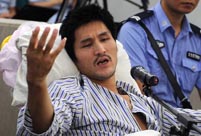SAKAI, Sept. 19 -- An intense battle between the incumbent mayor and a candidate nominated by Toru Hashimoto and his political group Osaka Ishin no Kai, a local group of the national party Nippon Ishin no Kai, has emerged in Japan's oldest "autonomous" city, thus stimulating new voter interest in whether or not to accept the Osaka Metropolis Plan.
The official election campaign for Sakai City, southern Osaka Prefecture, with its population of about 850,000, started on Sunday. Two candidates, current Mayor of Sakai Osami Takeyama, 63, and Katsutoshi Nishibayashi, 43, a former city council member backed by Hashimoto's group, are running. Both have canvassed streets near railway stations in the city, which is the prefecture 's second biggest in terms of population and area after Osaka City.
Interestingly, Takeyama was first supported by Hashimoto when elected mayor four years ago. He has since scrapped major public works projects and reduced administrative costs for the city office, including the abolishment of the mayor's retirement allowance of 28 million yen (about 280,000 U.S. dollars) and cutting personnel costs by 3.1 percent to save 1.4 billion yen ( about 14 million U.S. dollars) over the following two years.
According to the municipal election administration committee, news on the new candidate facing the incumbent mayor in the one-on- one race now draws more local attention than past mayoral elections. Officials at the committee's office told Xinhua that the expected voter turnout for the election, to be held later this month, will be more than 40 percent.
Local media note that residents in Sakai are now divided over the two candidates' policies. Takeyama states that no one will benefit from Hashimoto's metropolis plan, which he says will eventually destroy Sakai's independence.
"I firmly oppose approving the metropolis plan because its supporters are only targeting Sakai's revenues as a new resource for Osaka. Therefore, Sakai has no need for the proposal," Takeyama said.
Meanwhile, Nishibayashi argues for taking maximum advantage of broader-based local government as he urges Sakai residents to support the new idea.
If Sakai merges with Osaka and the prefectural government, then the estimated combined population will be 4 million. Nishibayashi believes the integrated metropolis will be able to compete with other major cities in Asia to boost the local economy.
Junichi Nagata, spokesperson for the committee, attributes the reason of strong interest among residents to the unique history of Sakai, which developed in the 16th century as the country's central port, known then as the "Venice of the East."
According to the city museum, the historic Jesuit missionary, Gaspar Vilela, who lived in Sakai for years, wrote in 1561 that Sakai is a large city and home to many powerful merchants. He further noted the city was "governed by consuls like Venice in Italy."
Writing later in 1565, Vilela elaborated that if an outsider is given permission to live in one section of the city, it is the custom for the other areas to accept the proposal. He called Sakai a strong city that was like a castle to live inside of.
As these writings describe, Sakai once became a prosperous harbor city self-governed by local merchants. A trade hub between Japan and China as well as South Asia and Europe, it was the largest commercial district in Asia.
But later, the shogun Hideyoshi Toyotomi, based in Osaka, completely abolished the autonomous system of Sakai, reportedly forcing the local merchants to move to central Osaka near his castle in order to weaken the powerful business community.
"Of course, the political character of Osaka Mayor Hashimoto has for better or worse made voters more interested in the upcoming election, but we cannot forget the city's history as an important factor that will influence the result," Rie Takeyama, a spokesperson for Takeyama's campaign team, said.
Regarding the Osaka-Sakai merger dispute, Takeyama earlier this month made a speech against the proposal in central Osaka, which was echoed by a group of over 20 mayors from major cities across Japan. Among them was Kobe Mayor Tatsuo Yada, who has strongly pushed his idea to reform the local governance system by delegating authority from prefectural governments to major cities with populations of 1 million people or more.
Ahead of the mayoral election, the political battle between the two candidates is expected to further heat up as they vie to gain more support from the local residents who will in the end choose whether to adopt a new system that eliminates redundant costs, or to protect their independent Sakai identity and avoid becoming " Osaka's subject" as they did in the past.
 Pakistan suffers desperate shortage of water
Pakistan suffers desperate shortage of water New model of indigenous surface-to-air missiles testfired
New model of indigenous surface-to-air missiles testfired  Heritage train ride across western Kosovo
Heritage train ride across western Kosovo Baby girl 'too young' for birthmarks treatment
Baby girl 'too young' for birthmarks treatment Beijing court hears airport blast case
Beijing court hears airport blast case Harbin named Chinese city with most beautiful women
Harbin named Chinese city with most beautiful women Wushu spirit
Wushu spirit Rugby girls
Rugby girls Funniest photos of sport stars as kids
Funniest photos of sport stars as kids  Residences of the royal house of Savoy
Residences of the royal house of Savoy China's frigate 'Bengbu'in fire training
China's frigate 'Bengbu'in fire training The last days of Wan Aihua
The last days of Wan Aihua Highlights at 12th National Games of China
Highlights at 12th National Games of China Beijing Film Academy welcomes freshmen
Beijing Film Academy welcomes freshmen 2013 Taiwan Int'l Tourism Expo kicks off in Taipei
2013 Taiwan Int'l Tourism Expo kicks off in TaipeiDay|Week|Month